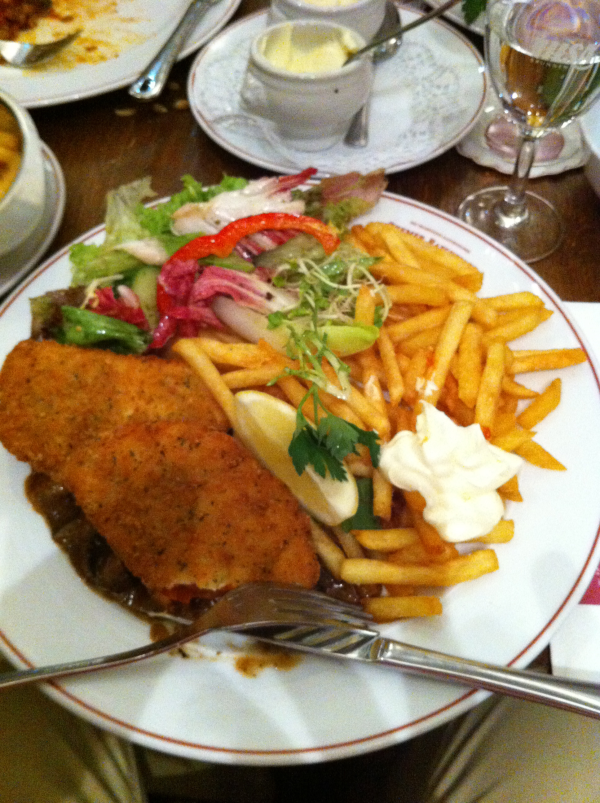When I was a kid, I used to walk home from my swimming club and stop every Friday night at the fish and chips shop. I would buy myself six pennyworth of chips with crackling. The crackling referred to the batter that had separated from the fried fish. With lots of salt and vinegar the crackling was as delicious as the fish and chips themselves.
It was not a healthy walk home, but one of the more delightful culinary events in my childhood. It was always wrapped in newspaper. Think of it this way – deep fried food covered in traces of lead with some salt and vinegar. That is what “Britishness” is all about.
This dish was spared wartime rationing (rationing actually was introduced in 1940 and did not end until 1954) to boost the fishing industry and it helped to keep the British population fed well during the difficult wartime years.
The dish of fish and chips owes its roots to the great expanding rail network in the 19th century, which was able to efficiently transport fish to the inland cities of England. From the north seaports to the fish and chips shops on the corners of smoky industrial towns, the British diet was transformed.
Even though it is tough to see, imagine the benefit of pairing fried potatoes with deep fried fish – it sure beat the alternatives! Remember these were the grim days of early British cuisine when garlic was simply something that French people chewed on their way to work. How could they?
Of course, nowadays things have changed. My fish and chips shop has long since gone, and most fish and chips shops have evolved into samosa, kebab, gyro, and fish and chip houses. The quality of the fish is not great, the chips are mainly from frozen bags, precut and tasteless, and the batter is grim.
But don’t despair, there definitely are places where you can still find fabulous fish and chips. I would strongly recommend any traveler to try one of these places:
Three trendy areas of London with superb fish and chips cooked perfectly in healthy batter with chips that are cut on the premises. The most popular fish to use in England is still cod followed by haddock, although I still have a deep fondness for dogfish, aka rock salmon. It’s the cheapest of cheap fish with a center bone like an eel. It is what I grew up on. And, let nobody ever tell you that you can eat fish and chips without healthy amounts of salt and malt vinegar. Ketchup and mayonnaise, while not forbidden, should be!
There are tons of great restaurants in London – probably the dining in and around London is the best in the world. But at least for one day, one lunch, it is worthwhile to grab some fish and chips and remember how it all started as a nutritional diet for the working classes during the industrial revolution. British at its best.

Photo of Fish and Chips courtesy of the best Fish and Chip place in Boston,
Island Creek Oyster Bar. Thanks to the kitchen for snapping this one, as it were!
Hungry for more? Check out our
ACIS EducationalTours itineraries to Great Britain and read more on London and al things British below.
Want to read more about London and our school trips to Great Britain
Hidden Gems of London
Must eat foods of London
Harry Potter in London
Royal Places to Visit in London

Peter Jones
In 1978, Peter Jones founded ACIS with a few colleagues, who all believed that travel changes lives.
Knowing the important difference between a trip that’s mediocre and one that’s extraordinary, he built ACIS from a deep belief and understanding that ACIS group leaders and participants deserve the best—from itinerary development to hotels to perhaps most importantly, the people hired to guide teachers and students throughout the journey.
“In 1978, Peter Jones founded ACIS with a few colleagues, who all believed that travel changes lives.
Knowing the important difference between a trip that’s mediocre and one that’s extraordinary, he built ACIS from a deep belief and understanding that ACIS group leaders and participants deserve the best—from itinerary development to hotels to perhaps most importantly, the people hired to guide teachers and students throughout the journey.”
 Photo of Fish and Chips courtesy of the best Fish and Chip place in Boston, Island Creek Oyster Bar. Thanks to the kitchen for snapping this one, as it were!
Hungry for more? Check out our ACIS EducationalTours itineraries to Great Britain and read more on London and al things British below.
Photo of Fish and Chips courtesy of the best Fish and Chip place in Boston, Island Creek Oyster Bar. Thanks to the kitchen for snapping this one, as it were!
Hungry for more? Check out our ACIS EducationalTours itineraries to Great Britain and read more on London and al things British below.









